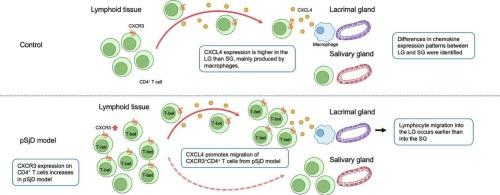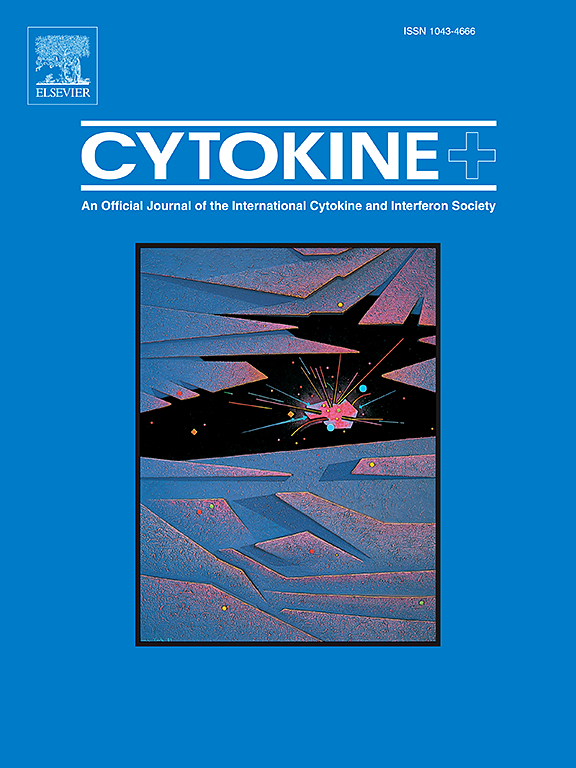原发性Sjögren疾病小鼠模型中泪腺和唾液腺的差异趋化因子谱
IF 3.7
3区 医学
Q2 BIOCHEMISTRY & MOLECULAR BIOLOGY
引用次数: 0
摘要
原发性Sjögren疾病(pSjD)是一种主要以泪腺(LGs)和唾液腺(SGs)为靶点的自身免疫性疾病。然而,LGs和SGs在免疫发病机制上的差异仍然知之甚少。在这项研究中,我们利用小鼠pSjD模型研究了lg特异性免疫反应与SGs的比较。对对照组和pSjD模型小鼠进行LGs和SGs的组织病理学分析。方法采用定量PCR方法检测18种与t细胞迁移相关的趋化因子的mRNA表达水平。通过原位杂交进一步检测LG组织中所选趋化因子的基因表达。使用流式细胞术和体外迁移试验评估t细胞的表型和功能。结果pSjD模型小鼠LGs的淋巴细胞浸润时间早于SGs。在分析的趋化因子中,C-X-C基序趋化因子配体4 (CXCL4)在LGs中特异性上调。Cxcl4的表达局限于LG组织内的巨噬细胞。此外,pSjD模型小鼠淋巴组织CD4+ t细胞上CXCR3的表达明显高于对照组。在pSjD模型小鼠中,T-bet在CXCR3+CD4+ T细胞中的表达高于CXCR3 - CD4+ T细胞。最后,CXCL4对pSjD模型小鼠CD4+ T细胞的迁移作用比对照组小鼠更有效。结论产生cxcl4的巨噬细胞可能促进pSjD中CXCR3+ Th1细胞募集到LGs,从而参与LGs特异性自身免疫性炎症。这一机制可能是治疗干眼症的潜在治疗靶点。本文章由计算机程序翻译,如有差异,请以英文原文为准。

Differential chemokine profiles between lacrimal and salivary glands in a murine model of primary Sjögren disease
Background
Primary Sjögren disease (pSjD) is an autoimmune disorder that primarily targets the lacrimal glands (LGs) and salivary glands (SGs). However, the differences in immune pathogenesis between LGs and SGs remain poorly understood. In this study, we investigated LG-specific immune responses in comparison to SGs using a murine model of pSjD. Histopathological analyses of LGs and SGs were conducted in control and pSjD model mice.
Methods
The mRNA expression levels of 18 chemokines associated with T-cell migration were evaluated by quantitative PCR. Gene expression of selected chemokines was further examined in LG tissues by in situ hybridization. The phenotype and function of T-cells were assessed using flow cytometry and in vitro migration assays.
Results
Lymphocytic infiltration was observed earlier in LGs than in SGs in pSjD model mice. Among the chemokines analyzed, C-X-C motif chemokine ligand 4 (CXCL4) was specifically upregulated in LGs. Cxcl4 expression was localized to macrophages within LG tissues. Moreover, CXCR3 expression on CD4+ T-cells in lymphoid tissues was significantly higher in pSjD model mice compared to controls. T-bet was more highly expressed in CXCR3+CD4+ T cells than in CXCR3−CD4+ T cells in pSjD model mice. Finally, CXCL4 enhanced the migration of CD4+ T cells derived from pSjD model mice more effectively than those from control mice.
Conclusions
These findings suggest that CXCL4-producing macrophages may promote the recruitment of CXCR3+ Th1 cells into the LGs in pSjD, thereby contributing to LG-specific autoimmune inflammation. This mechanism may represent a potential therapeutic target for managing dry eye in pSjD.
求助全文
通过发布文献求助,成功后即可免费获取论文全文。
去求助
来源期刊

Cytokine
医学-免疫学
CiteScore
7.60
自引率
2.60%
发文量
262
审稿时长
48 days
期刊介绍:
The journal Cytokine has an open access mirror journal Cytokine: X, sharing the same aims and scope, editorial team, submission system and rigorous peer review.
* Devoted exclusively to the study of the molecular biology, genetics, biochemistry, immunology, genome-wide association studies, pathobiology, diagnostic and clinical applications of all known interleukins, hematopoietic factors, growth factors, cytotoxins, interferons, new cytokines, and chemokines, Cytokine provides comprehensive coverage of cytokines and their mechanisms of actions, 12 times a year by publishing original high quality refereed scientific papers from prominent investigators in both the academic and industrial sectors.
We will publish 3 major types of manuscripts:
1) Original manuscripts describing research results.
2) Basic and clinical reviews describing cytokine actions and regulation.
3) Short commentaries/perspectives on recently published aspects of cytokines, pathogenesis and clinical results.
 求助内容:
求助内容: 应助结果提醒方式:
应助结果提醒方式:


